Sacred Signs : 5
Sacred Signs : 5
The range, genres and materials upon which hieratic texts are written is enormous and some examples are included here to give a small taste of the different levels of Egyptian society who recorded their lives and thoughts.
For copyright reasons I am unable to reproduce images of the documents referred to in this section. However, I provide some small snippets of the hieratic and cursive texts, rendered into hieroglyphs with transliteration and a translation. It may be possible to see the original texts and this is indicated if there is a web-site with images. The aim is to give a flavour of ‘real’ people speaking from Ancient Egypt in this world and the next.
Letters
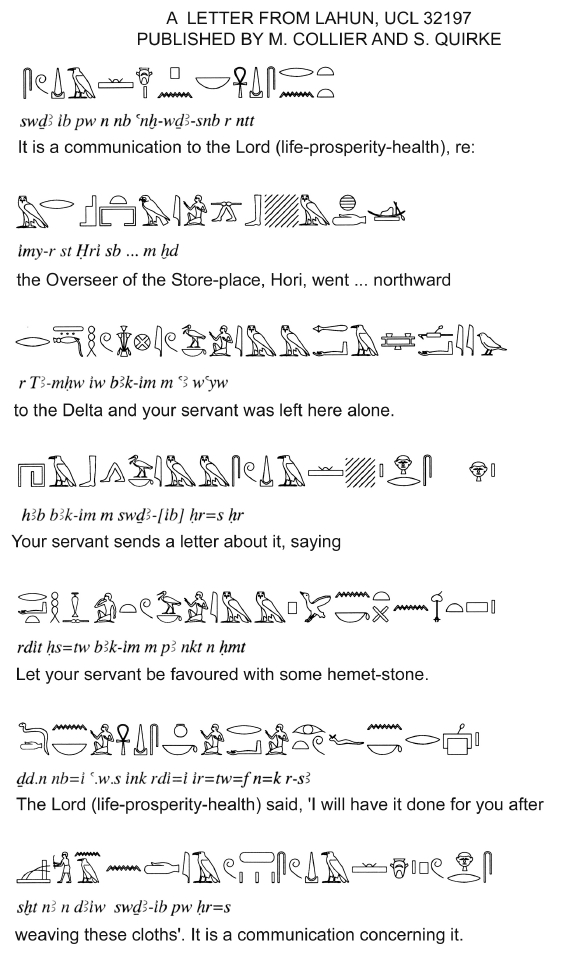
5.1 Lahun letter
This letter is written by a man who has been left in charge of a weaving workshop, perhaps in the town of Kahun. He has seen to the completion of his allotted work while his boss is on a business trip to the north. As a result he writes to remind his boss that he promised him some stone as his bonus.
The excerpt is part of a longer letter now re-published by M. Collier and S. Quirke, The UCL Lahun Papyri: Letters, BAR International Series 1083, Oxford 2002, p.88-89.
http://www.ucl/petriemuseum.ac.uk
Predictions and Advice
The Calendar of Lucky and Unlucky Days is a document detailing which days of the year are good and which days are bad. Many of the reasons for the nature of the days are given mythological connections. This means that the reason for the good or bad fortunes of people are based upon actions of and events which happened to the gods. Some of the reasons may relate to stories about the gods which have not otherwise survived.
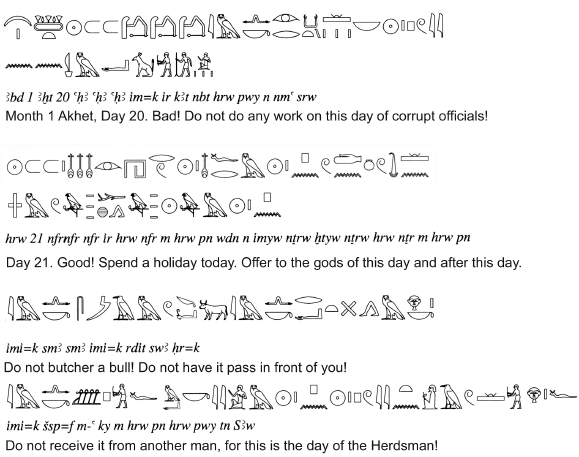
5.2 Akhet 1, Day 20 is technically 7th August (taking Akhet 1, Day 1 as 19th July the day of the beginning of the inundation), although as the civil calendar did not often match the seasonal calendar this is only a guide.
This is a bad day and the advice given almost amounts to an instruction to withhold labour because the bosses are corrupt.
Day 21 is a holiday in any case when an offering should be made to the gods, although this should not be beef. The day belongs to the Herdsman, although whether this is a mythical allusion is not clear. It may well refer to a god like Anubis who can look after cows.

5.3 Day 22 is a more complicated day. It is basically bad because of an occasion when Re was forced to deal with a group of beings who ‘approach’ or ‘attack’ him. It is not clear whether they are his enemies in human or divine form. Re dealt with them by eating them, breaking them down inside him and then spewing them out. They metamorphose so that their physical forms are fish and their spirits are birds. Because of the event it’s not a good idea to eat birds, fish or fatty things on this day. There does not seem to be any other allusion preserved to this story.
JokesThere is one joke recorded in a letter from P. Bibl. Nationale (Paris) 198, II. Text in J. Cerny, Late Ramesside Letters, Bruxelles 1939: no. 46 lines 67,12-68,2 (excerpted from longer letter); translation now in E. Wente, Letters from Ancient Egypt, Atlanta: Scholar’s Press, 1990, p.173. It dates to Year 12 of Ramesses XI.

5.4 Joke.
Cursive Hieroglyphs
The ‘Books of the Dead’ are most often the kind of text written in cursive hieroglyphs and many examples exist in many museums. The example given is just one spell from a papyrus containing up to 200 separate spells to enable the deceased to reach the afterlife successfully. It is Spell 180 from the ‘Book of Amduat (what is in the Underworld)’, written in a Paris Museum Papyrus. The text is taken from E.W. Budge, The Chapters of Coming Forth by Day or the Theban Recension of the Book of the Dead, London 1910, p.92-93.

5.5 Book of the Dead
Autobiographies
Formal and informal biographies occur on stelae, in tombs and on statues from the earliest times in Ancient Egypt into the Roman period. It was important for people to show their status to other people and the gods and for their memory to continue for ever. Some autobiographies give an insight into special events during an individual’s life, especially those connected with their job.
Amenemhab
Amenemhab was a ‘Deputy’ or Lieutenant of Tuthmose III in his army during his campaigns into Syria in the later part of his reign. Amenemhab’s tomb at Thebes is one of a group of men who served with and under Tuthmose III and may represent a kind of military elite around the king during the Empire period of the New Kingdom. Amenemhab’s career is a fine example of a brave soldier who distinguished himself by his dogged campaigning and quick thinking in times of crisis.
The Elephant
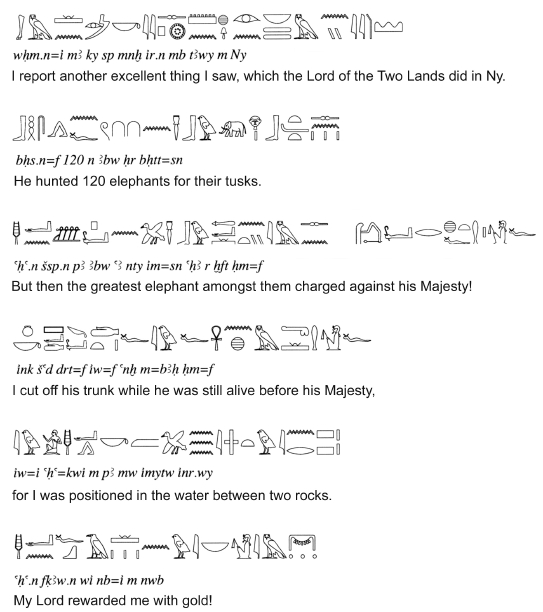
5.6 In this excerpt the hunting prowess of the king is used as a background against which Amenemhab shows his bravery against the charging elephant and the implication is that he saved the king’s life.
The Mare
Qadesh was a key city at the confluence of major trading routes in Syria. Its control was therefore of considerable importance to the Great Powers of the Bronze Age, including Egypt of course. Tuthmose III campaigned in the area to bring Qadesh under Egyptian control and thus have access to the whole trading network of the Near East. The ruler of Qadesh was, however, a wily individual.
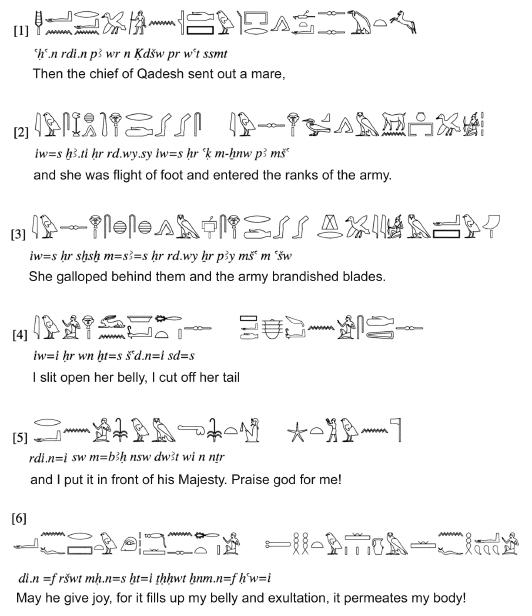
5.7
The ruler of Qadesh must have hoped to disrupt the army ranks of the Egyptians by this ploy and perhaps to have distracted the Egyptian horses, causing yet more confusion. Amenemhab seems to have been in the best position (again) to react and calm a potentially embarrassing situation.
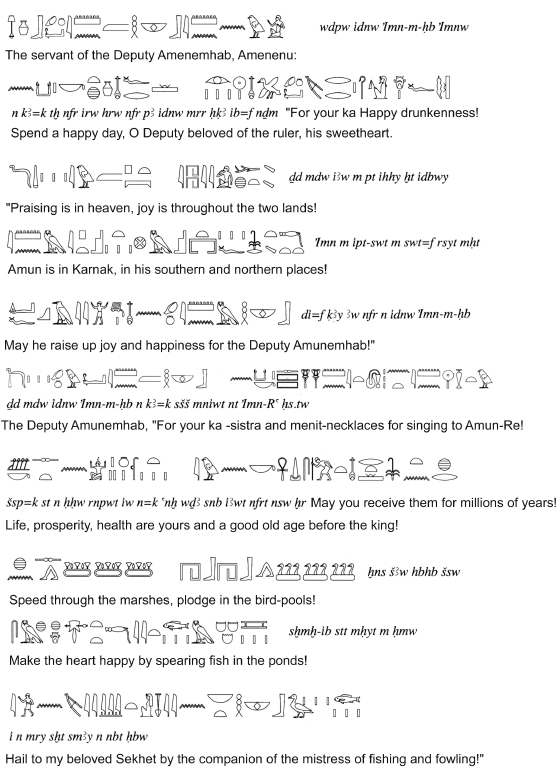
5.8 The servant of Amenemhab left a song written in his master’s tomb which was intended to provide as much joy for him in the afterlife as it had done in this one.
Ikhernofret
Ikhernofret was a priest serving in the cult of Osiris at Abydos. Each year an important Mystery festival took place there. The image of Osiris was brought out in a boat and carried in procession to his ritual burial place at Paker (Umm el Gaab). As the boat was carried it was ceremonially attacked and the priests accompanying the boat had to beat off the attackers and protect the god. At the conclusion of the battle, Osiris could be triumphantly buried in his tomb. The man responsible for managing and organising this event in the Middle Kingdom was Ikhernofret. His stela tells us exactly what he did and how successful he was in his job.
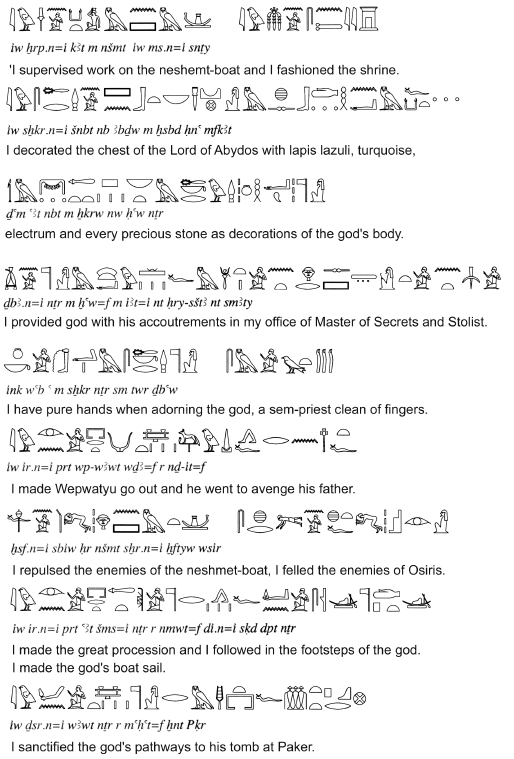
5.9
